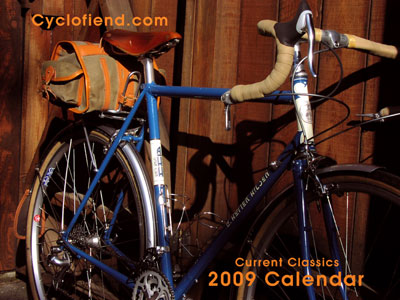Cyclofiend.com:
Guidelines for Submission ![]()

Your
donation helps to support this site and its upkeep.
Cyclofiend.com Current Classics Calendar
Beginning in 2009, I've begun publishing an annual color calendar featuring bicycles from the galleries in Cyclofiend.com. These are drawn from the photos which people have sent in. I'm hoping to make this an annual event, and will be drawing images from the galleries.
So, if you want to be included in the running for next year's calendar, get those photos submitted! (And they really should be in to me before August for the next year's edition)
For more information about the calendar, you can send an email to
calendar (overat) cyclofiend (dit) com
"Hey
there - I have a 'Current Classic'
a cool Cross bike a Single
Speed or a serious Working Bike!
How do I get my bicycle into the gallery?"
|
It's Simple - Follow these steps: 1 - Take five (5) photos of the bicycle. 2 - Write a brief description about your bicycle 3 - Attach the photos to an email and send to the right group 4 - Look for an email response
|
||
| 1 - Take five (5) photos of the bicycle. | ||
|
a) Focus - The bicycle to be photographed is basically "air" - that is your fancy camera's autofocus will look for something to fix on - probably whatever is behind your bicycle. You can usually lock in the focus by aiming at the ground in from of the bicycle, then moving up to compose the shot. b) Lighting - Use natural lighting. Outside sunlight is best. Morning and evening sun is better still. Don't bother going outside at lunchtime to take the picture, because the highlights will be fried and the shadows will look like the darkest depths of Mordor. Overcast days often can supply very nice, even lighting. Keep the sun behind you, unless you know what the phrase "fill flash" means. b) Lighting Addendum - White bicycle frames can be very tough to get right - if you shoot them against a too dark background, your camera can be fooled. It tries to split the difference, which washes out your bicycle and lightens up the shadows. If you then make a scan of that, it gets out of control in a big hurry. If you see "graininess" in the shadows, that's the camera/scanner trying to lighten it up. Try to shoot it against a background where the light is hitting both the bicycle and the background. Or, shoot it in open shade where the light is even. b) Shadow Addendum - If you shoot in strong shadows, you photo will gain a lot of contrast. Since cameras and computer screens don't deal with a range of light as well as your eye, contrasty photos lose detail. This example has very low contrast - it was a bright, overcast day. This example shows high contrast on a white bicycle - bright sun too close to midday. b) More Involved Examples - Ray Dobbins has put together a good reference of home-built studio photography techniques. His tips are quite good, and some of his bicycles are quite mind-bogglingly beautiful. Check it out here. c) Composition Tips - Stop before you snap the shutter. Look at what you are about to commit to film...err...pixels. Look at each corner of the frame - are there things that distract from the bicycle? How big is the bicycle in the frame? If it takes up less than a third, you probably are too far away. Look "through" the bicycle - is there a bag of old fast-food splattered on the sidewalk? Does the seattube seem to continue into a street sign? Simple is better. Closer is better. d) To Send Your Photo - Save or transfer the photo "for the web". Most new cameras seem to have a decent way to scale down a picture. What you send should be no wider than 800 pixels (and no smaller than 350). You can "Open" the photo in your web browser to get an idea - most will tell you the size when you do this. For comparison, the photos on this page are (at left) 250 and (right) 150 pixels wide. Unless you changed it, your camera probably likes to save things much, much larger than that. What you send really shouldn't be llarger than 1 mb - more like 250 - 500k per photo. The photos should be JPEG format. If all this talk about conversions and transfering and sizes makes your eyes glaze over, just send what you have - you're actually better off sending me a bigger version. I have a number of photo & image manipulation tools and can probably deal with it just fine unless it is some odd "native" format that your camera uses. e) No more than 5 photos per post. If you send more, I may not post #6 or higher. If you can do it with less - great! Mix 'em up a little! People like to see component or lug details. Make sure you get a nice "overview" shot. It's fun to see what your world is like - setting the bicycle in your local interesting or unique locale is even better - here's a great example. As with vacation photos - leave 'em wanting more. Don't just take a whole bunch at slightly different angles. f) Vertical vs Horizontal. (Or - Portrait vs Landscape) Either way is OK. I crop the photos so they are no more than 800 pixels at the longest measurement. Note - I do select one of your photos to be the "Random" shot which shows up in one of various places. For formatting reasons, this is the horizontal shot, so please make sure to include at least one horizontally composed photo in the group.
|
||
| 2 - Write a brief description about your bicycle | ||
|
I won't be fixing your typos, so please reread your prose for spelling & logical errors. If possible, please use plain text format for your email - don't use all the fancy bold, italics or color text that your email program supplies. It's nice to nclude your city/state/province/country or other locational info. I generally will snip specific addresses.
|
||
| 3 - Email the photos as attachments to the appropriate group. | ||
|
To Email the photos Prepare an email using your mail program or webmail interface. Attach the photos to the email. If you are sending a series (for fender or rack mounting) attach them in viewing order. Do not compress the photos or use .zip software Check again that your photos are attached. You might also double check that you haven't attached "thumbnails" Get ready to click "Send", then check one more time that the photos are attached. Click that "Send" button Basic Group Descriptions: Current
Classic - If it has been created by a maker who is still torching or brazing, all the better! But, the focus of this section is on bicycles which were made after about 1978. If that sounds confusing and you think it's classic, send it to currentclassics@cyclofiend.com!
Cross Bike / Cyclocross Bicycle
- Singlespeed/Single
Speed - Working
Bikes & Practical Hardware - (More about definitons in the FAQ) A
Word About Email Addresses - Unless I receive specific instructions otherwise, I will include (a) the email you put in the body of your submission or (b) the email from which you send the submission. If you don't want me to do that, please put "No Email Please" at the top of your submission. If you spell out your email - e.g. "bob at bob dot org" - I will leave that in the text as you typed it, but won't make it into a hyperlink.
|
||
| 4 - Look for an email response | ||
|
Yes, I do have a real job, so there may be a delay. But, I do enjoy putting these web projects together, so it shouldn't take too long. If something is wrong, I'll let you know. Otherwise, I'll give you a rough idea of my next update. There is no charge for this. I may add some advertising in the future, and have set up Paypal Donations button on the site to defray hosting costs. This will be what you all make it. Get creative and have fun!
|
||
| And, PLEASE ! | ||
|
-
Do not send photos for bikes you are selling. That's not what this
is about.
|
||
|
Yep, there's a FAQ page now...
|
||
|
|
||
| Current Classics Gallery | Cross Bike Gallery | |
| Single Speed Garage | Working
Bikes & Practical Hardware |
|


Animal Rescue & Recovery During Disasters

Noah's Wish
Animal Disaster Rescue & Recovery
Animal Rescue Groups
Grand Tour Daily Reports - Coffee-fueled updates
-- Click here to subscribe to Cyclofiend.com Daily Updates! --
Tour Reports :
2002 Giro D'Italia - 2002 Tour de France
Photo Pages:
Cyclocross
Nationals - 2002
- San
Francisco Grand Prix Road Race - 2002
- San
Francisco Grand Prix - 2001
Cyclocross
Nationals - 1999 - Men's
Elite - Women's Elite
- Other Photos
Some Photos from 1998 SuperCross -

 g)
The photo should be of the bicycle only. Pets (especially
rescue animals such as Tashi, at right) are always welcome in the
frame, but there should not be recognizable people included in the
shot. If you include human folks, I will intentionally blur them
or crop them out of the photo.
g)
The photo should be of the bicycle only. Pets (especially
rescue animals such as Tashi, at right) are always welcome in the
frame, but there should not be recognizable people included in the
shot. If you include human folks, I will intentionally blur them
or crop them out of the photo. 

